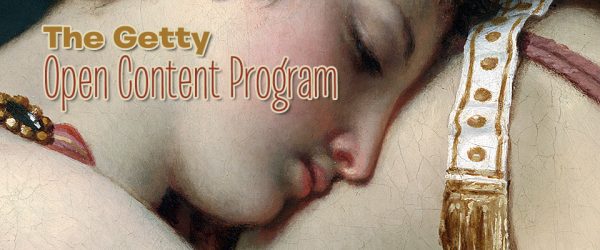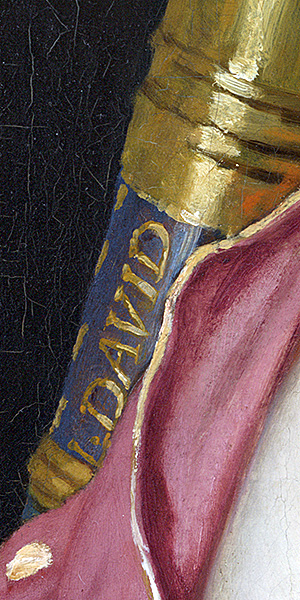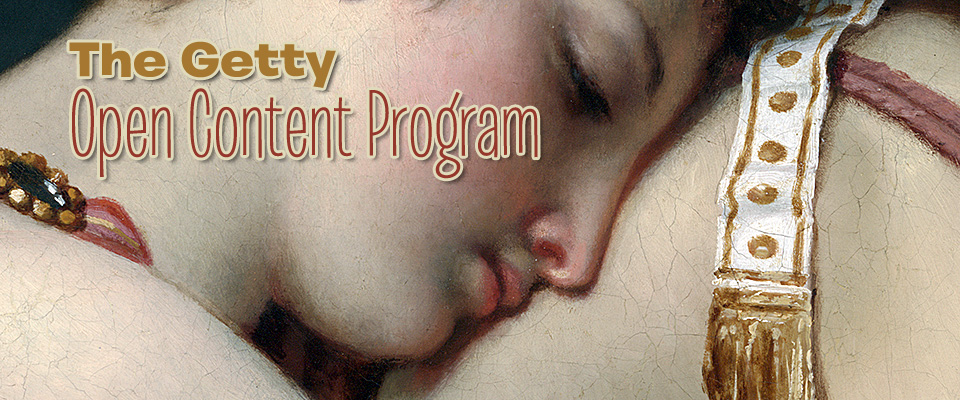
Jacques-Louis David (French, 1748 – 1825)
The Farewell of Telemachus and Eucharis, 1818, Oil on canvas
Unframed: 88.3 x 103.2 cm (34 3/4 x 40 5/8 in.)
Framed [outer dim]: 118.4 x 136.2 x 7.6 cm (46 5/8 x 53 5/8 x 3 in.)
The J. Paul Getty Museum, Los Angeles
Open Content Program The Getty
Yesterday the world’s richest museum embraced free culture. In a blog post on The Getty Iris, James Cuno, president and CEO of the J. Paul Getty Trust, announced The Getty’s new Open Content Program.
Today the Getty becomes an even more engaged digital citizen, one that shares its collections, research, and knowledge more openly than ever before. We’ve launched the Open Content Program to share, freely and without restriction, as many of the Getty’s digital resources as possible.
Vision
I can’t applaud The Getty’s vision enough. This is a wonderful move to share the world’s culture with all the people of the world. Or at least with the 2/7th wired part of the world. But that proportion grows every day and as new global citizens come online what a magnificent resource awaits them.
 The images on this post are details of Jacques-Louis David’s The Farewell of Telemachus and Eucharis. Earlier in his career David’s work was much more politically charged. This painting comes from later in his life and is, obviously, far more romantic.
The images on this post are details of Jacques-Louis David’s The Farewell of Telemachus and Eucharis. Earlier in his career David’s work was much more politically charged. This painting comes from later in his life and is, obviously, far more romantic.
Download
Thanks to the Open Content Program I effortlessly downloaded the high quality 4005 x 3418 pixel scan of the image. It’s an image you can easily view wide to appreciate the composition, or zoom in to see David’s brush work and the cracks of time on the paint surface.
Cuno promises that this gift of culture is only the beginning, “We plan to release many more images of works of art in the public domain over time, both from the Museum’s collection and from the special collections of the Getty Research Institute. We’re conducting a thorough review of copyright and privacy restrictions on our holdings to identify all the images we can make available.”
The Knowledge Century
I’ve written recently about some of 2013’s sad events in terms of freedom and culture. The Getty’s move yesterday is the Knowledge Century as I’ve always believed it should be, and dreamt that it would be. Perhaps it is a conceit to call one century “The Knowledge Century.” Perhaps a better term would be “The Information Century.” Or “The Networked Century.” Suffice to say, the intersection of networked technology with inquisitive minds is The Enlightenment Writ Large. In yesterday’s blog post Cuno further wrote,
The Getty was founded on the conviction that understanding art makes the world a better place, and sharing our digital resources is the natural extension of that belief. This move is also an educational imperative. Artists, students, teachers, writers, and countless others rely on artwork images to learn, tell stories, exchange ideas, and feed their own creativity.
A year ago I reported on The Walters Art Museum of Baltimore uploading 19,000 images to the Wikimedia Commons repository. Yesterday The Getty made available through it’s own websites 4,600 high resolution images. Some images are up to 100mb in size. All carry metadata. I’ve never done a systematic look at how many institutions now offer part of their collection as free culture. I only learned of these two great efforts through press releases that happened to come to me. It seems like a daunting task, but next week I’ll endeavour to make a more comprehensive list of cultural intuitions with free culture offerings.
I believe that fair use allows me to quote Cuno’s blog post. It is disappointing given this wonderful move to read on The Getty’s terms of use page that except for these 4,600 images, every word on any Getty website is proprietary. Yesterday The Getty opened it’s collection to the world. Why not it’s ideas as well?
L i n k y . L i n k y
• The Getty Iris / Open Content, An Idea Whose Time Has Come
• The Getty Trust / Press Release / Getty Announces New Program Lifting Restrictions on Use of Digital Images
• The Getty Trust / About The Open Content Program
• The Getty / Terms of Use / Copyright
• The J. Paul Getty Museum / The Farewell of Telemachus and Eucharis
• New Media Consortium / Horizon Report 2012 / Museum Edition
• iRez / The Walters Art Museum



Digital images courtesy of the Getty’s Open Content Program.

Wonderful ♥
Kudos!